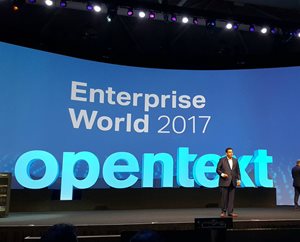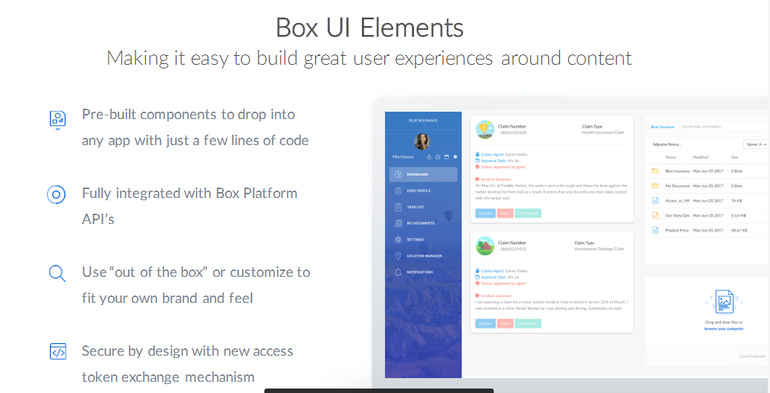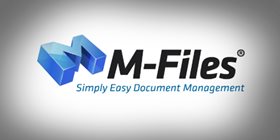Latest Enterprise Content Management Innovations
By Venus Tamturk
July 18, 2017
Artificial Intelligence, Box, CMS News, Enterprise, Enterprise Content Management, IBM, IoT, machine learning, Magellan, M-Files, OpenText, SAP
In today’s ever-changing technology landscape, remaining essential means going backwards. Keeping this in mind, almost all major Enterprise Content Management (ECM) vendors have lately been rolling out a set of new tools for their content management platforms to help their customers tackle a wide range of enterprise issues from productivity to time-to-market. This article will give a glimpse into what ECM vendors have recently been up to by encapsulating their latest innovation news.
OpenText Reveals Content Management AI Platform
As you may recall, last year, during his opening keynote at the OpenText Enterprise World 2016  event, OpenText CTO and CEO Mark Barrenechea took aim at IBM’s cognitive learning engine, Watson, pointing out its closed ecosystem, limited deployment options, and high cost. This year, Barrenechea didn’t change his ritual as he, once again, made it loud and clear that OpenText’s AI platform, called Magellan, is designed to compete directly with IBM’s Watson: “It’s Watson [that we’re targeting]. What differentiates us is that the information-centric applications that we already have will be integrated directly with Magellan. We don’t want to extract information – from contracts, for example – out of applications and into an AI platform. The fact that you have to feed Watson with data extracted from multiple resources, I think, is a weakness.”
event, OpenText CTO and CEO Mark Barrenechea took aim at IBM’s cognitive learning engine, Watson, pointing out its closed ecosystem, limited deployment options, and high cost. This year, Barrenechea didn’t change his ritual as he, once again, made it loud and clear that OpenText’s AI platform, called Magellan, is designed to compete directly with IBM’s Watson: “It’s Watson [that we’re targeting]. What differentiates us is that the information-centric applications that we already have will be integrated directly with Magellan. We don’t want to extract information – from contracts, for example – out of applications and into an AI platform. The fact that you have to feed Watson with data extracted from multiple resources, I think, is a weakness.”
During our interview with OpenText CMO Adam Howatson, he said: “Say, I’m paying 10 million dollars a year to haul 50 petabytes of data. I don’t want to do that for compliance and corporate memory reasons anymore, I want to put that data to work to inform my market, to inform my customer interactions, to inform my selling cycle, to inform my engineering divisions, and I think that will be a pretty profound pivot.” That’s exactly one of the areas Barrenechea believes Magellan can stand out as he claims that "Watson's data lake is a swamp” whereas The Magellan AI platform “brings insight into transactions and data.”
During the event, the vendor also shed light on immediate use cases of OpenText's new AI platform in verticals from human resources tasks like employee self-service, recruitment, and retention of fleet management, such as marketing personalization, inventory utilization, and vehicle maintenance. With text mining and semantic analysis, the vendor built its AI platform to help enterprises orchestrate unstructured and semi-structured information, in areas such as enterprise content management, customer experience, and data discovery. Here are some use cases that explain how the platform can unlock the value of enterprise data:
-
Leverage Machine Learning to unlock the value of EIM data by analyzing customers, trading partners, employees, orders, invoices, cases, documents and other data managed in these systems.
-
Deliver value from AI faster and cost-effectively by deploying a cohesive platform with pre-integrated components to minimize the effort and expertise required to go live.
-
Democratize access to AI by empowering data scientists to create custom algorithms for use by business analysts and operational users.
-
Utilize an open-source, Apache Spark-based platform to automatically derive the most current and complete insights from Big Data and EIM Content to achieve optimal outcomes.
-
Augment applications automatically with fast, self-service analytics, empowering business users to delve deep into massive amounts of data and derive actionable insight.
The product will be available as an appliance that runs on pre-configured, commodity hardware and available on premises or via the cloud. However, given an explosion of enterprise AI products, OpenText is trying to make its platform more appealing through not only by running on Apache Spark and supporting Hadoop structures, but also selling the product at a much lower price point than, especially, IBM Watson. Barrenechea claimed Magellan could be set up at one-sixth the cost of a comparable IBM Watson implementation.
Box Focuses More on Artificial Intelligence and Machine Learning
Last month, here at CMS-Connected, we reported on reaching a cash-flow profitability milestone  and discussed the transformation the company has gone through so far as well as what the future direction is they are heading. The vendor has successfully capitalized on the transition to cloud and mobile, once and still the major transformative change, for moving forward, it is currently working on new features powered by artificial intelligence. "The first core principle is that we have to grow fast enough to capture this opportunity," stated Box CEO Aaron Levie in late June. Soon enough, the company announced a deepening relationship with Microsoft to co-sell its cloud content management platform with Azure to enterprise customers, and add Microsoft's machine learning and artificial intelligence services into its platform.
and discussed the transformation the company has gone through so far as well as what the future direction is they are heading. The vendor has successfully capitalized on the transition to cloud and mobile, once and still the major transformative change, for moving forward, it is currently working on new features powered by artificial intelligence. "The first core principle is that we have to grow fast enough to capture this opportunity," stated Box CEO Aaron Levie in late June. Soon enough, the company announced a deepening relationship with Microsoft to co-sell its cloud content management platform with Azure to enterprise customers, and add Microsoft's machine learning and artificial intelligence services into its platform.
With this partnership, Box will save time and money on R&D as the vendor brings intelligent experiences into Box through a strategic partnership, while providing Microsoft with a leg up on the stiff competition against its rival cloud vendors Google and Amazon due to the potential exposure to Box's enterprise customer base, which includes 64 percent of the Fortune 500. “We want to be the most open cloud content management platform in the world. We will go wherever the innovation goes,” Jeetu Patel, Box SVP of Platform and Chief Strategy Officer, told in an interview. This is the first time the cloud document-management company will offer customers the option of specifying which public cloud provider will store their Box data, the company said.
Box has been poaching enterprise accounts and enticing developers into building apps that keep users engaged on its services in recent years. Therefore, besides its partnerships with Microsoft for bolstering its platform’s intelligence capabilities, the vendor also rolled out the first in a series of embeddable components to make it easier for businesses to incorporate a Box-style content management experience into their own applications. Given Box has 100,000 developers using its services in their apps, enabling those developers to deliver Box functionality with a few lines of code gives the vendor a great competitive edge in the enterprise world where the complex enterprise digital ecosystem is becoming a formidable challenge for organizations.
Eventually, the vendor plans to roll out three categories of Box Elements; a series of UI elements, backend service elements, and industry-specific app elements. However, only a series of UI elements are available for now. Here are the components of Box UI elements:

-
Box Content Uploader which allows users to drag and drop files into an application, or select local files from their device, and upload them securely to Box.
-
Box Content Explorer which lets users navigate a set of files or folders stored in Box from within an app.
-
Box Content Preview which displays interactive views for more than 120 different types of files (such as documents, images, videos, or 3D files) directly in an application.
-
Box Content Picker which enables users to select files or folders stored in Box from within an app.
M-Files Injects AI Capabilities to Content Management Tools
As the pace of business and the need for collaboration persist to accelerate, enterprises were struggling with managing and protecting their sensitive content as well as enabling their multi-cultural teams to collaborate on the same project in real time. This situation has led ECM vendors to rethink how enterprise content is managed and they conducted that enterprises need solutions which can, say, categorize large volumes of content exponentially faster than humans. This conclusion set a domino effect in the motion of rising ECM vendors to adopt stronger, more tightly integrated artificial intelligence capabilities through either acquisition or from building the capabilities in-house. M-Files is one of many enterprise content management system providers that have recently waded into the foray as it added more AI functionality to its platform through a partnership with ABBYY, an artificial intelligence (AI), text-scanning and optical character recognition software company.
struggling with managing and protecting their sensitive content as well as enabling their multi-cultural teams to collaborate on the same project in real time. This situation has led ECM vendors to rethink how enterprise content is managed and they conducted that enterprises need solutions which can, say, categorize large volumes of content exponentially faster than humans. This conclusion set a domino effect in the motion of rising ECM vendors to adopt stronger, more tightly integrated artificial intelligence capabilities through either acquisition or from building the capabilities in-house. M-Files is one of many enterprise content management system providers that have recently waded into the foray as it added more AI functionality to its platform through a partnership with ABBYY, an artificial intelligence (AI), text-scanning and optical character recognition software company.
The expected result of this partnership is to provide a more intelligent and streamlined information environment that ensures consistency in how content is categorized and intelligently linked to other relevant data, content, and processes. "Our partnership with ABBYY brings a strong complement of artificial intelligence capabilities to our core platform to further transform and automate the way our customers manage information and related processes," says Mika Javanainen, vice president of product management at M-Files Corporation. "By assisting in the process of automatically categorizing files with metadata, ABBYY technology is like jet fuel to the M-Files metadata-driven architecture, intelligently offloading users from repetitive tasks while making information more easily discoverable across the organization."
SAP Leverages Leonardo Platform with New IoT Solutions
Let’s move on one of the most emerging technology innovation trends, artificial intelligence, to  another, Internet of Things (IoT). During its SAP Leonardo Live conference, the vendor introduced four new "industry accelerators" that enable customers to rapidly design and deploy applications with processes that are specific to their industry.
another, Internet of Things (IoT). During its SAP Leonardo Live conference, the vendor introduced four new "industry accelerators" that enable customers to rapidly design and deploy applications with processes that are specific to their industry.
For those who are not familiar with the platform, Leonardo is a cloud service that can help ingest, process and make sense of the hordes of IoT data. "SAP Leonardo brings a lot of our innovation technologies together and the approach we're taking is very much about how we help customers implement a system of innovation very rapidly," said David Jonker, SAP senior director of predictive analytics. In other words, the primary point of the platform is to help customers develop digital transformation projects with advanced technologies like IoT.
The vendor released the first industry accelerators for the retail, consumer products, discrete manufacturing, and sports and entertainment industries back In May when it, first, rolled out Leonardo. The new industry accelerators are for chemicals, travel, and transportation, and utilities will be added to the portfolio. Here are the solutions that SAP introduced during the event:
-
SAP Leonardo IoT Bridge, a configurable role-based digital command center giving operations managers unprecedented visibility and ability to act in real time
-
SAP Global Track and Trace, a cloud-based offering for unified, end-to-end tracking, monitoring and reporting of objects and business processes across supply chain networks
-
SAP Edge Services to bring compute, storage and business semantics via the cloud to where intelligent devices reside outside of the data center, for near real-time and deterministic performance of business processes
-
SAP Digital Manufacturing Insights, a centralized, cloud-based manufacturing performance management solution that provides comprehensive visibility into manufacturing that enables process optimization
-
SAP Asset Manager, a cloud-based mobile app for managing asset health, inventory, maintenance and safety
CMS-Connected previously reported on the findings which a 451 Research survey revealed that 71% of enterprises are gathering data for IoT initiatives today. The same survey also disclosed that IoT's lack of perceived Return on Investment (ROI) and benefits is the second top impediment according to 41 percent of respondents. With these innovations, SAP is aiming to help those, who are struggling to find their place in the IoT-enabled landscape, discover their business cases for this emerging technology.
My POV
Gartner has projected that 40 percent of new enterprise applications implemented by service providers will include AI technologies by 2021. One of the most prominent drivers behind this fast-emerging trend is that enterprises are really looking for solutions that work end to end and the advanced technologies like artificial intelligence bridges the gaps on organizations’ digital transformation and innovation journeys.
To satiate this obvious interest and get the lion share from the market, vendors are in a stiff competition to beef up their platforms with the power of new technologies. To appeal enterprises, vendors are either executing a lower cost of entry strategy like the case of OpenText’s Magellan vs IBM Watson or conducting thorough market research to address straight to the pain points that customers are facing. For example, regarding the newly expanded partnership between Box and Microsoft, the CEO Aaron Levie said Box has spent the past few quarters mentioning the idea to clients and assessing interest, which he said is significant. The results of technology partnerships do not only help ECM vendors innovate more and more but also ripple out into many disciplines in the tech industry. Microsoft, for instance, works on matching Amazon’s lengthy list by adding partners and products to its portfolio. Additionally, it wants to meet customer demand for a variety of cloud offerings to win the cloud technology supremacy battle among public cloud providers, especially, Amazon Web Services, which has an annual run rate revenue of about $12.2 billion, and Google which has an annual run rate revenue of about $1 billion.

Venus Tamturk
Venus is the Media Reporter for CMS-Connected, with one of her tasks to write thorough articles by creating the most up-to-date and engaging content using B2B digital marketing. She enjoys increasing brand equity and conversion through the strategic use of social media channels and integrated media marketing plans.